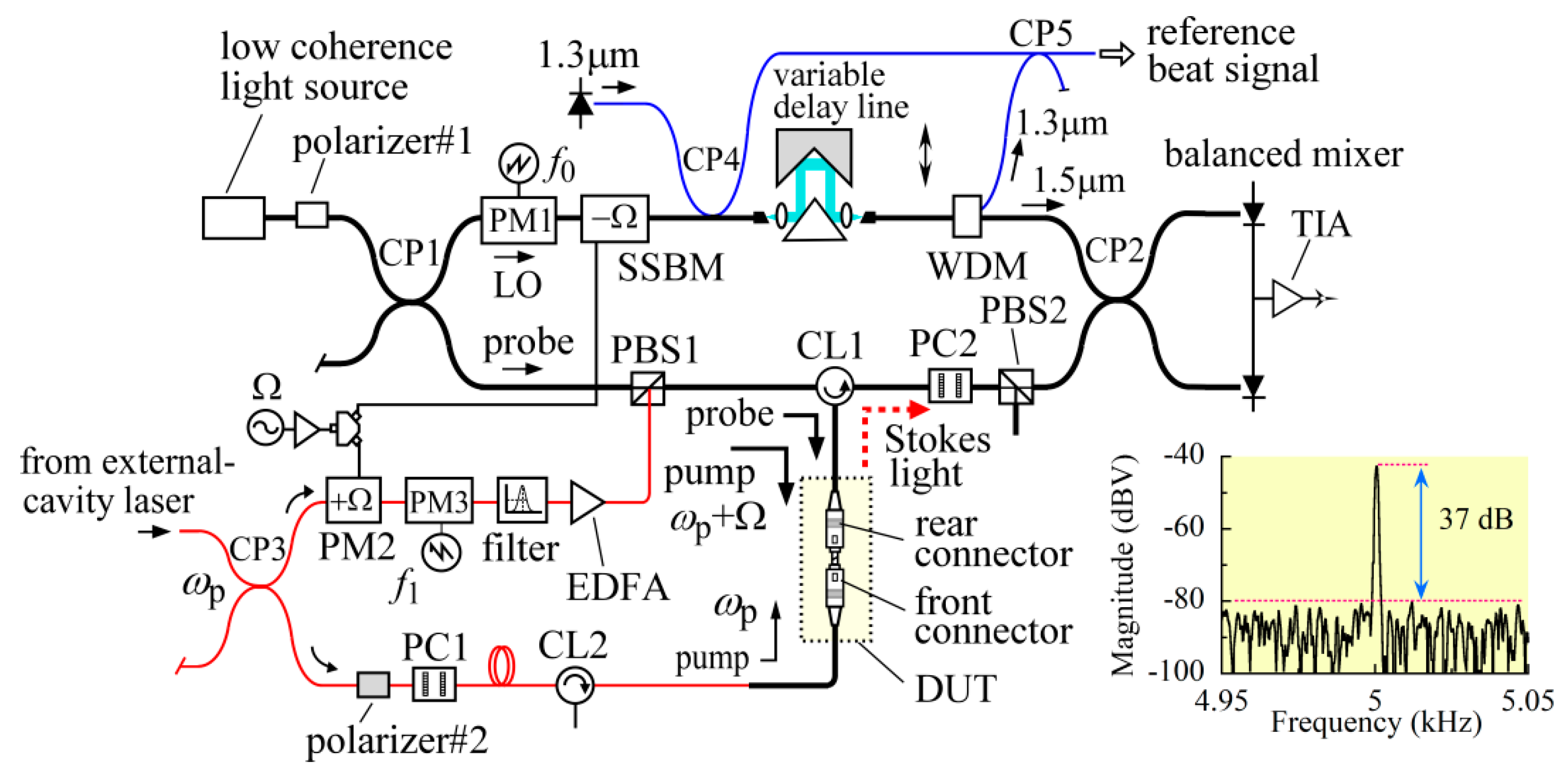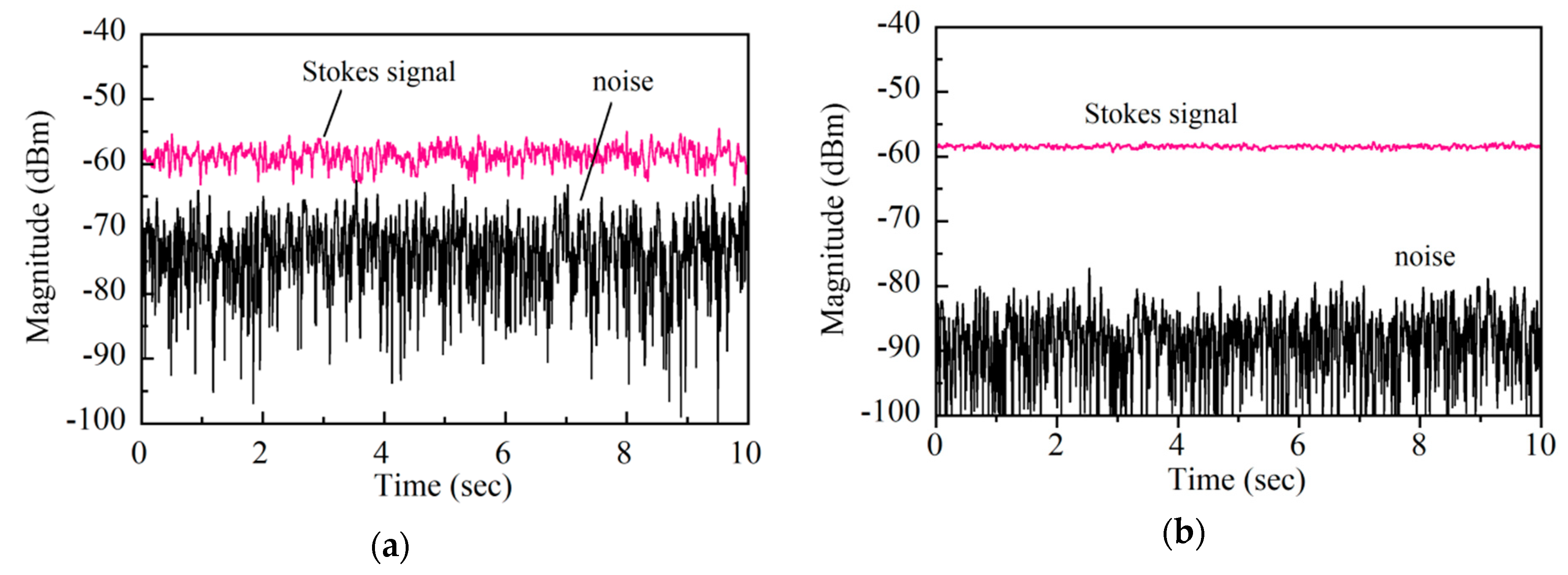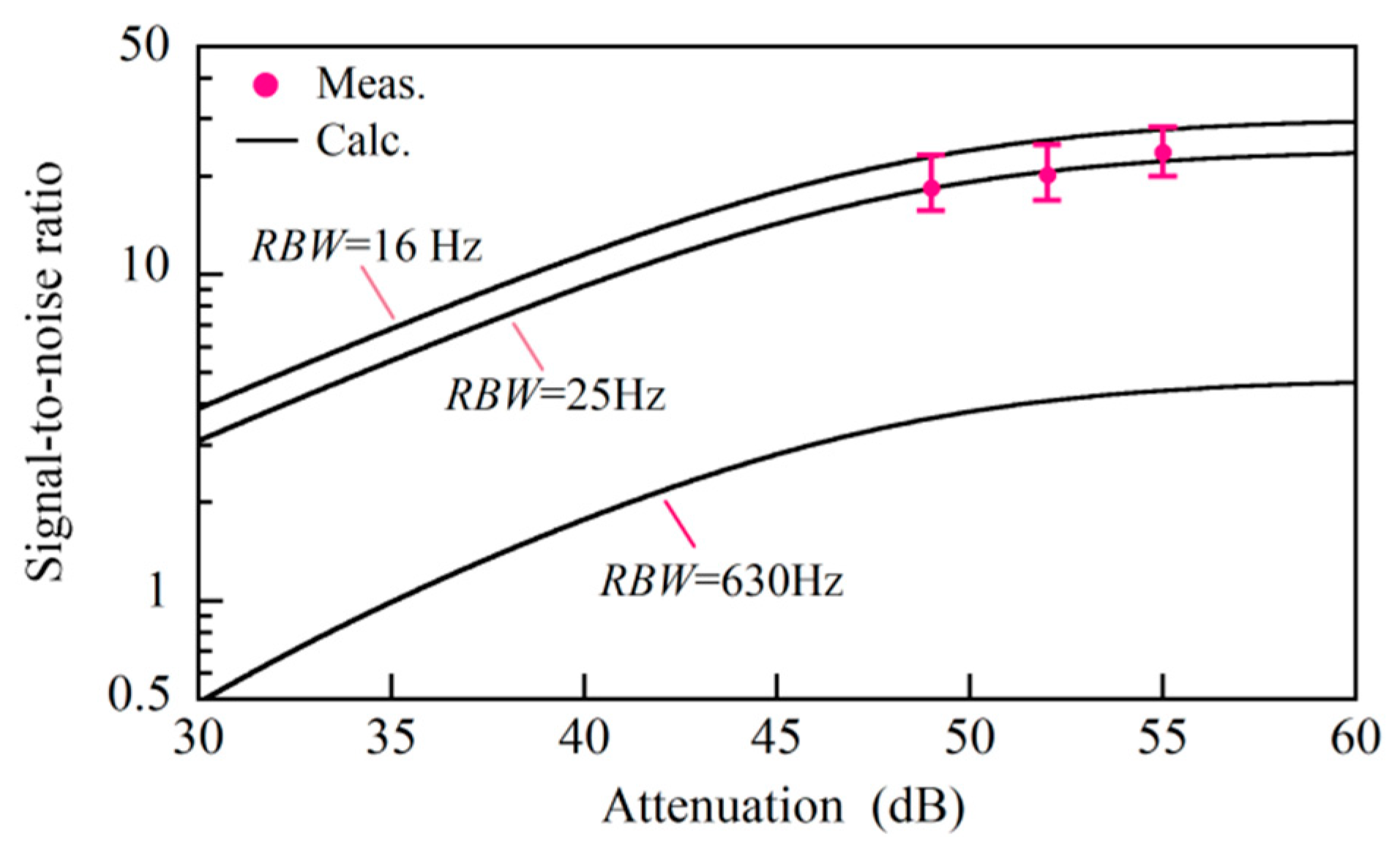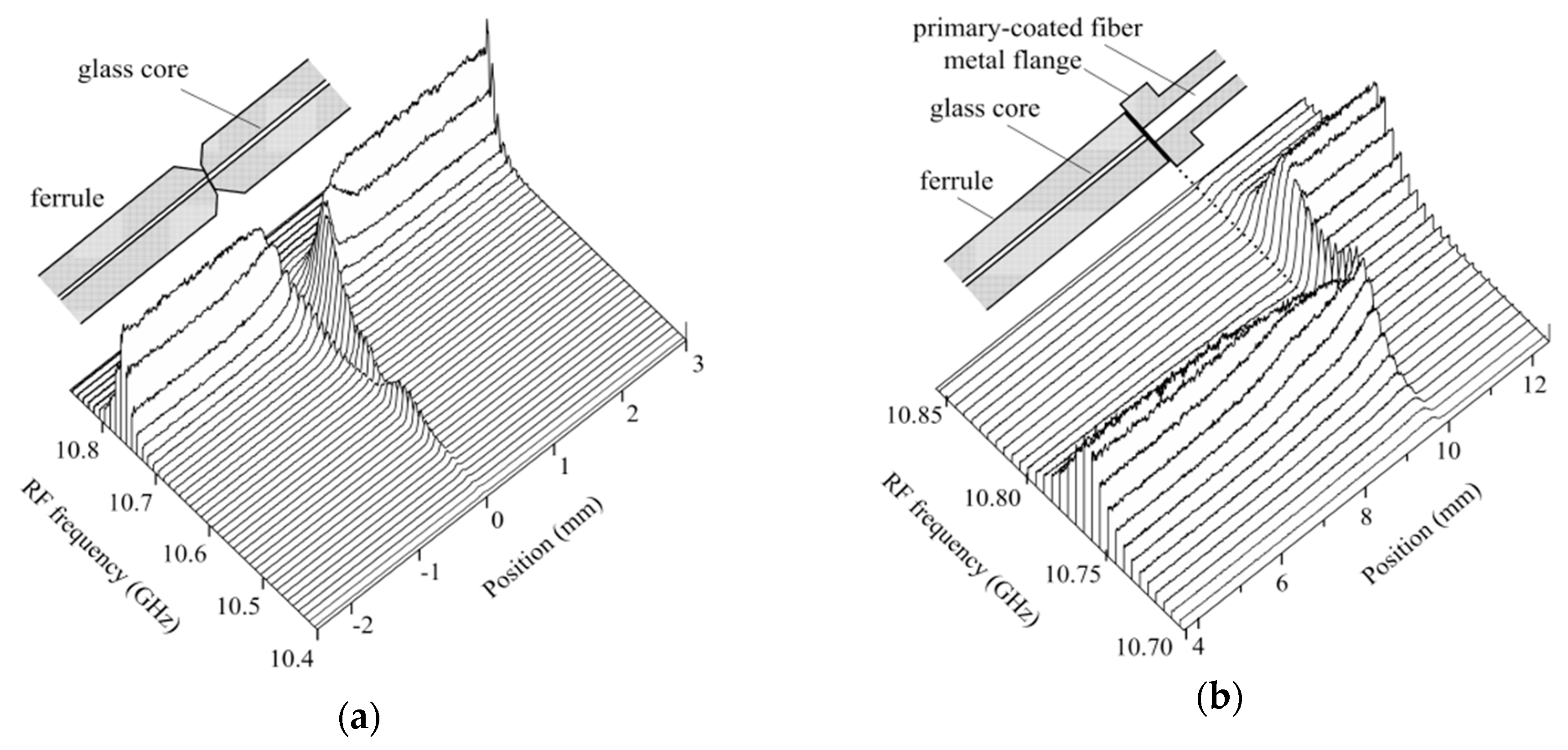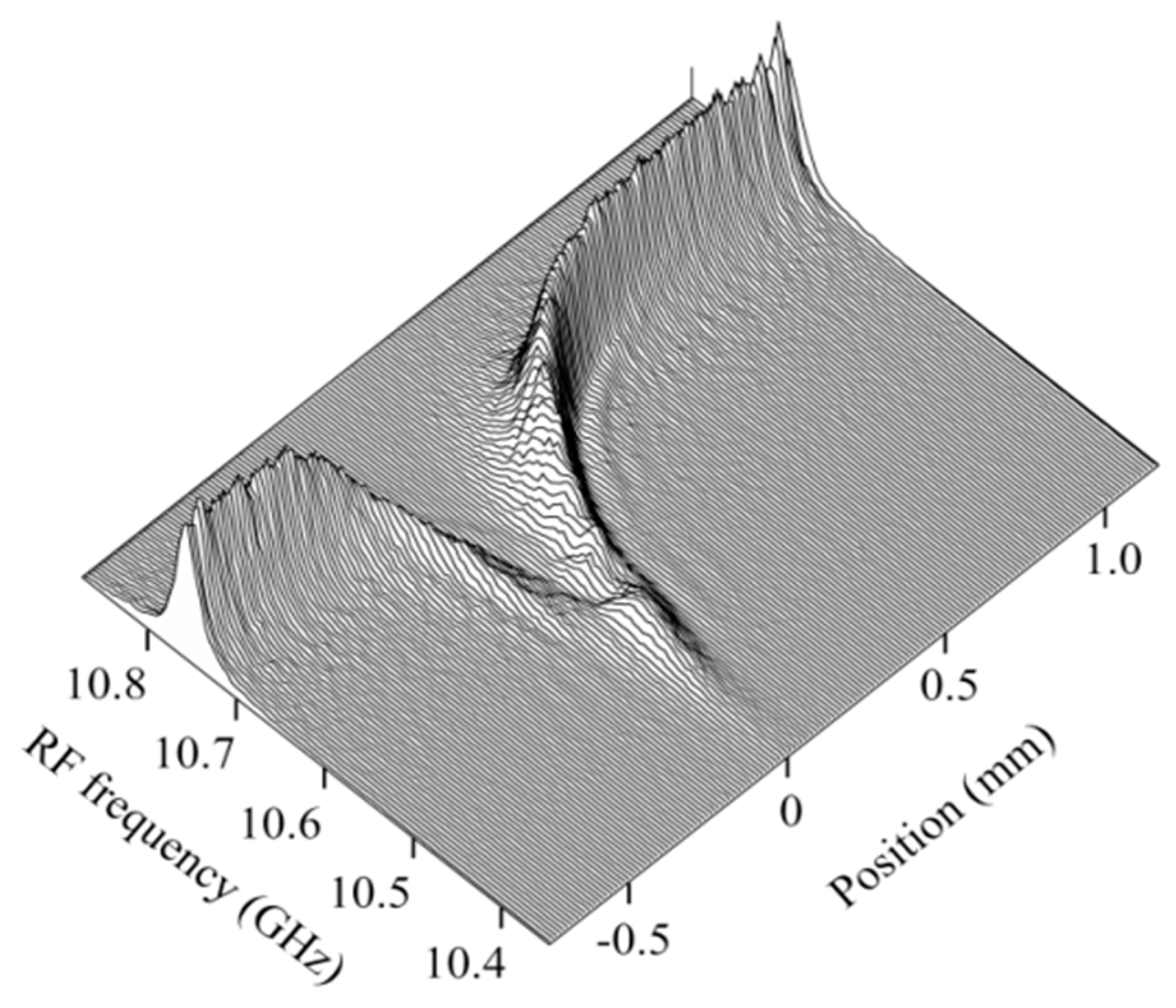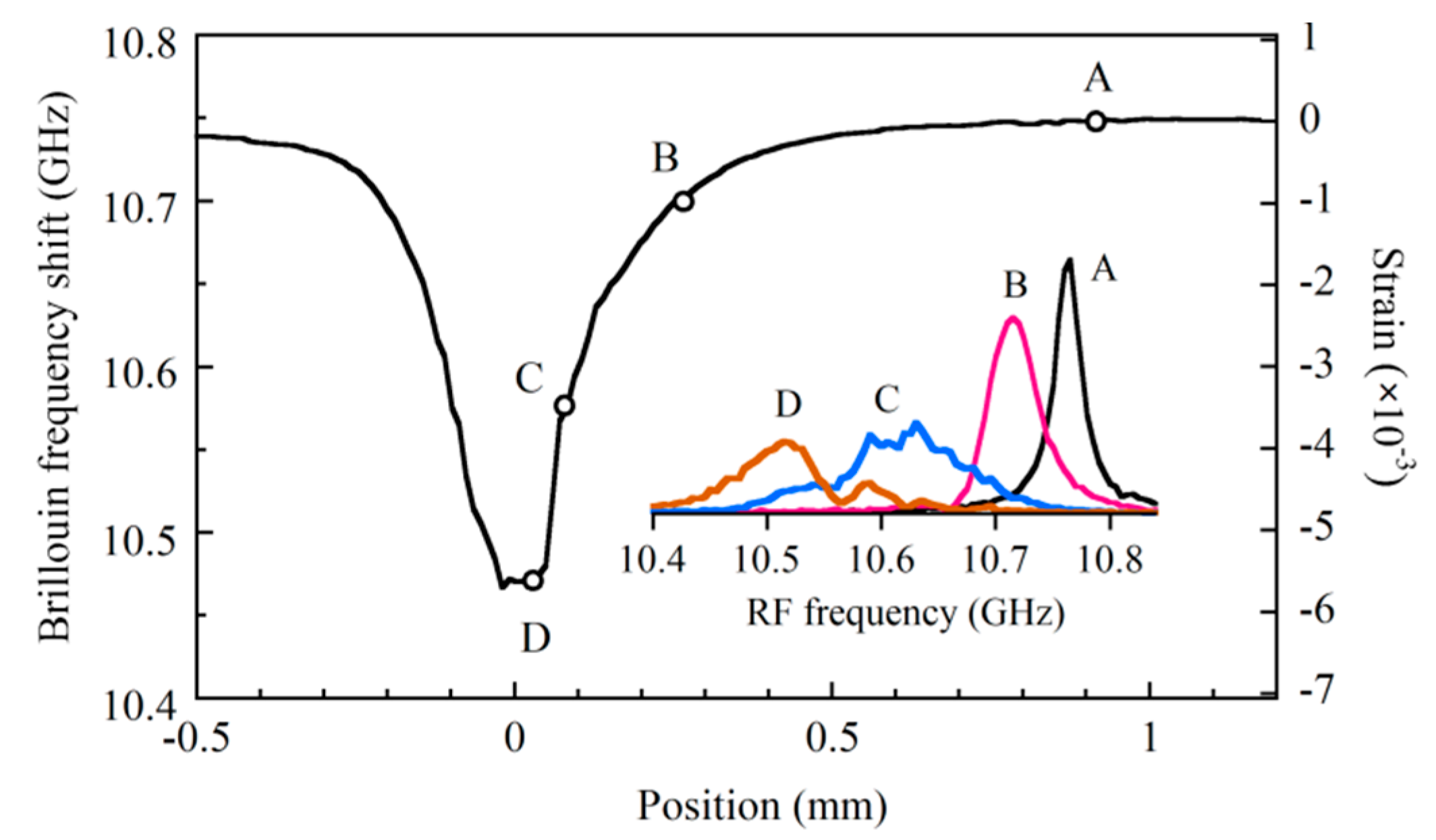Figure 1.
Schematic of Brillouin grating-based OLCR incorporating dispersive Fourier spectroscopy (DFS). The inset shows the spectrum of the Stokes signal acquired with an FFT signal analyzer. DUT: device under test, CL1 and CL2: optical circulators, CP1,CP2,, CP5: 3-dB fiber couplers, EDFA: erbium-doped fiber amplifier, PC1 and PC2: polarization controllers, PBS1 and PBS2: polarization beam splitters, SSBM: single-sideband modulator, PM1~PM3: phase modulators, WDM: wavelength-division multiplexer, LO: local oscillator, TIA: transimpedance amplifier, ωp: pump light frequency, Ω: down-conversion frequency, f0 = 145 kHz, f1 = 150 kHz.
Figure 1.
Schematic of Brillouin grating-based OLCR incorporating dispersive Fourier spectroscopy (DFS). The inset shows the spectrum of the Stokes signal acquired with an FFT signal analyzer. DUT: device under test, CL1 and CL2: optical circulators, CP1,CP2,, CP5: 3-dB fiber couplers, EDFA: erbium-doped fiber amplifier, PC1 and PC2: polarization controllers, PBS1 and PBS2: polarization beam splitters, SSBM: single-sideband modulator, PM1~PM3: phase modulators, WDM: wavelength-division multiplexer, LO: local oscillator, TIA: transimpedance amplifier, ωp: pump light frequency, Ω: down-conversion frequency, f0 = 145 kHz, f1 = 150 kHz.
Figure 2.
Brillouin grating distributions around the joint of the mated angle-polished fiber connectors, which were measured with the OLCR incorporating the DFS. The down-conversion frequencies applied to the SSBM were 10.47 and 10.5 GHz. The probe light and the pump light at ωp + Ω propagated from rear to front connectors, whereas the pump light at ωp propagated in the opposite direction.
Figure 2.
Brillouin grating distributions around the joint of the mated angle-polished fiber connectors, which were measured with the OLCR incorporating the DFS. The down-conversion frequencies applied to the SSBM were 10.47 and 10.5 GHz. The probe light and the pump light at ωp + Ω propagated from rear to front connectors, whereas the pump light at ωp propagated in the opposite direction.
Figure 3.
Propagation of the light waves ΔEpr, ΔEp1 and ΔEp2, which were generated from the probe light Epr, pump light Ep1 at ωp + Ω and Ep2 at ωp, respectively, and entered the balanced mixer to produce beat noise. ILO and Ipr are the mean photocurrents produced if the respective LO and probe lights would be detected with a photodiode. Pp1 and Pp2 are the light powers of the pump lights at ωp + Ω and ωp, respectively. CL1: optical circulator, TIA: transimpedance amplifier. A schematic of the square-law detection and the relation between the constituent spectral densities are also shown. (a) shape of the low-pass filter whose width is VBW. The center frequency and the bandwidth of the band-pass filter are fc and RBW, respectively. The constituent spectral density functions denoted as Equations (A1)–(A3) are represented by (b), (c) and (d), respectively.
Figure 3.
Propagation of the light waves ΔEpr, ΔEp1 and ΔEp2, which were generated from the probe light Epr, pump light Ep1 at ωp + Ω and Ep2 at ωp, respectively, and entered the balanced mixer to produce beat noise. ILO and Ipr are the mean photocurrents produced if the respective LO and probe lights would be detected with a photodiode. Pp1 and Pp2 are the light powers of the pump lights at ωp + Ω and ωp, respectively. CL1: optical circulator, TIA: transimpedance amplifier. A schematic of the square-law detection and the relation between the constituent spectral densities are also shown. (a) shape of the low-pass filter whose width is VBW. The center frequency and the bandwidth of the band-pass filter are fc and RBW, respectively. The constituent spectral density functions denoted as Equations (A1)–(A3) are represented by (b), (c) and (d), respectively.
Figure 4.
Magnitude of the Stokes signal as a function of the photocurrent ILO of the probe light when (a) the power Pp1 of the pump light at ωp + Ω was 50, 100 and 200 mW, where the power Pp2 of the pump light at ωp was fixed at 12 mW, and (b) Pp2 = 3, 6, and 12 mW, where Pp1 was fixed at 200 mW. The solid lines were plotted by calculating CsILOIprPp1Pp2 with Cs = 4.29 × 10−5.
Figure 4.
Magnitude of the Stokes signal as a function of the photocurrent ILO of the probe light when (a) the power Pp1 of the pump light at ωp + Ω was 50, 100 and 200 mW, where the power Pp2 of the pump light at ωp was fixed at 12 mW, and (b) Pp2 = 3, 6, and 12 mW, where Pp1 was fixed at 200 mW. The solid lines were plotted by calculating CsILOIprPp1Pp2 with Cs = 4.29 × 10−5.
Figure 5.
Current noise spectral density as a function of photocurrent ILO measured when the power of the pump light at ωp that entered the balanced mixer was changed so that the photocurrent was ΔIp2 = 80, 320 or 1280 nA. Both the probe light and the pump light at ωp + Ω were blocked. The photocurrent was ΔIp2 = 80 nA when the pump light was attenuated by 55 dB. The solid lines were plotted by calculating σ2 = 2e(ILO + ΔIp2) + σ2LO×P2 at different ΔIp2 values.
Figure 5.
Current noise spectral density as a function of photocurrent ILO measured when the power of the pump light at ωp that entered the balanced mixer was changed so that the photocurrent was ΔIp2 = 80, 320 or 1280 nA. Both the probe light and the pump light at ωp + Ω were blocked. The photocurrent was ΔIp2 = 80 nA when the pump light was attenuated by 55 dB. The solid lines were plotted by calculating σ2 = 2e(ILO + ΔIp2) + σ2LO×P2 at different ΔIp2 values.
Figure 6.
Current noise spectral density as a function of photocurrent ILO measured when all the lights were launched and the total power of both pump lights that entered the balanced mixer was changed so that their total photocurrent was ΔIp = 80, 160 or 320 nA. The solid lines were plotted by calculating σ2 = 2e(ILO + ΔIpr + ΔIp) + σ2LO×pr + σ2LO×p at different ΔIp values.
Figure 6.
Current noise spectral density as a function of photocurrent ILO measured when all the lights were launched and the total power of both pump lights that entered the balanced mixer was changed so that their total photocurrent was ΔIp = 80, 160 or 320 nA. The solid lines were plotted by calculating σ2 = 2e(ILO + ΔIpr + ΔIp) + σ2LO×pr + σ2LO×p at different ΔIp values.
Figure 7.
Time change of video output from an RF spectrum analyzer set at 5 kHz, a zero span, VBW = 100 Hz and RBW = 30 Hz when (a) DR = 12.5 dB and SNR = 3.05 and (b) DR = 28 dB and SNR = 18.1. The linear stage used in the variable delay line was fixed at a particular position and the down-conversion frequency was 10.77 GHz.
Figure 7.
Time change of video output from an RF spectrum analyzer set at 5 kHz, a zero span, VBW = 100 Hz and RBW = 30 Hz when (a) DR = 12.5 dB and SNR = 3.05 and (b) DR = 28 dB and SNR = 18.1. The linear stage used in the variable delay line was fixed at a particular position and the down-conversion frequency was 10.77 GHz.
Figure 8.
Relationship between dynamic range and signal-to-noise ratio. The dynamic range was changed by changing the power of the pump lights entering the balanced mixer. The solid line is a theoretical curve of the function described by Equation (22).
Figure 8.
Relationship between dynamic range and signal-to-noise ratio. The dynamic range was changed by changing the power of the pump lights entering the balanced mixer. The solid line is a theoretical curve of the function described by Equation (22).
Figure 9.
(a) Brillouin grating reflectogram around the joint of the mated fiber connectors, which was derived from one scan of the linear stage. (b) Mean reflectogram derived by averaging 10 reflectograms. The reflectograms were derived by processing the acquired interferograms with the DFS.
Figure 9.
(a) Brillouin grating reflectogram around the joint of the mated fiber connectors, which was derived from one scan of the linear stage. (b) Mean reflectogram derived by averaging 10 reflectograms. The reflectograms were derived by processing the acquired interferograms with the DFS.
Figure 10.
Attenuation dependent signal-to-noise ratio of a Brillouin grating reflectogram that was acquired by processing one interferogram with the DFS. Attenuation was defined by ΔIp/Ip2 on a logarithmic dB scale, where Ip2 was the photocurrent produced if the pump light at ωp were to be detected with a photodiode. Theoretical curves were plotted for three resolution bandwidths of RBW = 16, 25 and 630 Hz.
Figure 10.
Attenuation dependent signal-to-noise ratio of a Brillouin grating reflectogram that was acquired by processing one interferogram with the DFS. Attenuation was defined by ΔIp/Ip2 on a logarithmic dB scale, where Ip2 was the photocurrent produced if the pump light at ωp were to be detected with a photodiode. Theoretical curves were plotted for three resolution bandwidths of RBW = 16, 25 and 630 Hz.
Figure 11.
Mean Brillouin grating reflectograms acquired around the (a) joint and (b) boundary between the ferrule and metal flange of the front connector. The individual reflectograms were derived by processing the interferograms with the DFS.
Figure 11.
Mean Brillouin grating reflectograms acquired around the (a) joint and (b) boundary between the ferrule and metal flange of the front connector. The individual reflectograms were derived by processing the interferograms with the DFS.
Figure 12.
Distribution of Brillouin spectrum around the joint of the mated fiber connectors. The distribution was obtained by first acquiring the Stokes signal as a function of position (or Brillouin grating distribution) at different down-conversion frequencies and then plotting the signal as a function of the frequency at equidistant spaces.
Figure 12.
Distribution of Brillouin spectrum around the joint of the mated fiber connectors. The distribution was obtained by first acquiring the Stokes signal as a function of position (or Brillouin grating distribution) at different down-conversion frequencies and then plotting the signal as a function of the frequency at equidistant spaces.
Figure 13.
Change in Brillouin frequency shift along the mated fiber connectors. Inset shows Brillouin spectra at particular points A, B, C and D. The frequency shift was rescaled to give the deviation of the strain from that at point A by using a strain constant of 4.93 MHz/10−4 at 1.55 μm.
Figure 13.
Change in Brillouin frequency shift along the mated fiber connectors. Inset shows Brillouin spectra at particular points A, B, C and D. The frequency shift was rescaled to give the deviation of the strain from that at point A by using a strain constant of 4.93 MHz/10−4 at 1.55 μm.
Figure 14.
Brillouin grating distributions at different down-conversion frequencies measured around the fused region of a 3-dB fused biconically-tapered single-mode fiber coupler with input and output ports. The coordinates of points A, B, C and D are −8, 8, 0 and 1.5 cm, respectively.
Figure 14.
Brillouin grating distributions at different down-conversion frequencies measured around the fused region of a 3-dB fused biconically-tapered single-mode fiber coupler with input and output ports. The coordinates of points A, B, C and D are −8, 8, 0 and 1.5 cm, respectively.
Figure 15.
Distribution of Brillouin spectrum around the fused region of the fiber coupler. The main distribution is shown by (ii), which was associated with the small signal distribution shown by (ii).
Figure 15.
Distribution of Brillouin spectrum around the fused region of the fiber coupler. The main distribution is shown by (ii), which was associated with the small signal distribution shown by (ii).
